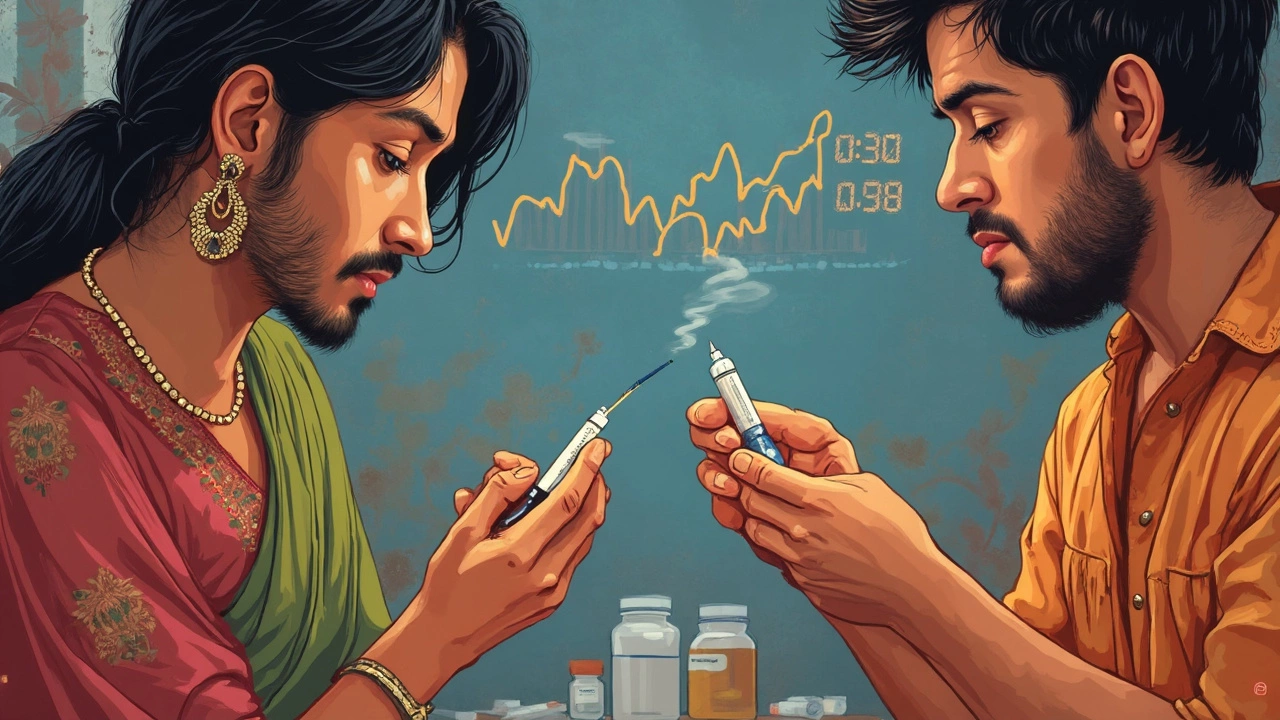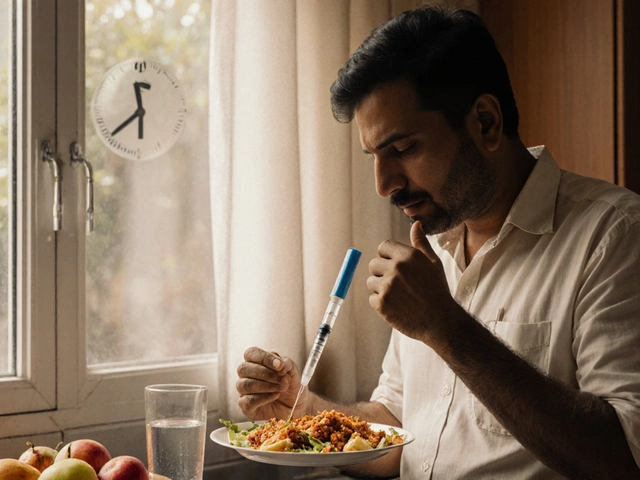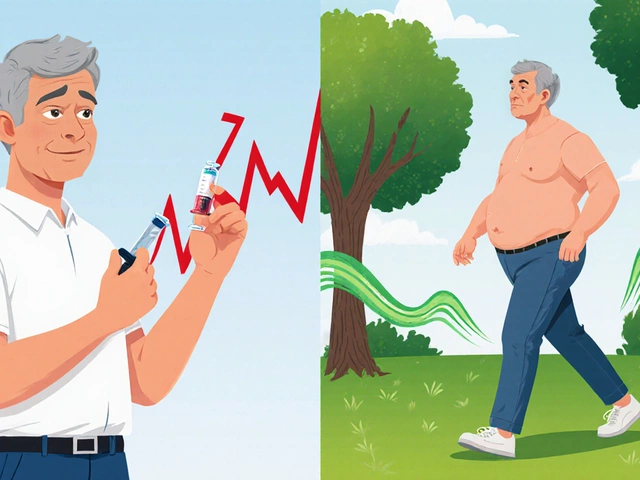If you ask someone living with diabetes what messes up their day, they’ll probably say: blood sugar that refuses to play nice. People sometimes think all diabetes is more or less the same, but that’s way off. It’s actually a whole bunch of different conditions, and some are just brutal to manage.
Ever notice how some people seem to handle their diabetes like clockwork, while others are constantly battling highs and lows? It’s not just about willpower. The type of diabetes you have stacks the deck in different ways. Honestly, some types just fight dirty; medication, food, stress—everything can make numbers jump. And don’t even get me started on the stuff that throws things off for no obvious reason at all.
Understanding which diabetes is truly the hardest to control can clear up a lot of confusion, especially if you’re wrestling with meds, routines, or mystery symptoms. Hang tight as we break down what’s really going on inside the body, which types are sneakiest, and what actually helps—besides just hoping for a good day.
- What Makes Some Diabetes So Hard to Manage?
- Type 1 vs. Type 2: Which Throws More Curveballs?
- Medications: Why One Size Never Fits All
- Common Roadblocks (and How to Dodge Them)
- Smart Moves for Tough-to-Control Diabetes
What Makes Some Diabetes So Hard to Manage?
Here’s something you might not know: the main reason some types of diabetes are tough to manage isn’t just sugar itself—it’s the way your body can (or can’t) handle insulin. Insulin is that hormone that acts like a key, letting sugar move from your blood into your cells. When this process breaks down, managing diabetes goes from a simple routine to a constant guessing game.
The hardest diabetes types to control usually have one or more of the following issues:
- Unpredictable insulin needs: The body’s need for insulin changes all the time, especially if there’s no natural insulin being made (like in type 1 diabetes).
- Hormonal shifts: Stuff like puberty, pregnancy, stress, or even just getting sick can send blood sugar all over the place.
- Sensitivity to tiny changes: Sometimes, a little extra carbs or one skipped dose can send blood sugar sky-high or crashing low.
- Other health problems: Conditions like celiac disease, hypothyroidism, or PCOS can mess with diabetes management, especially for folks with type 1 or young kids.
Look at the numbers—it’s a tricky business. Here’s a quick comparison showing how often people hit their target blood sugar based on diabetes type (based on recent surveys and studies):
| Diabetes Type | % Meeting Target Blood Sugar (HbA1c <7%) |
|---|---|
| Type 1 | About 20% |
| Type 2 (on insulin) | Roughly 33% |
| Type 2 (on pills only) | Close to 50% |
If your head’s spinning, you’re not alone. For many, the hardest part isn’t just taking meds but figuring out dozens of little decisions all day—every meal, every workout, every late-night snack. Toss in job stress or a cold, and your plan can go sideways fast.
So when people ask which diabetes is hardest to control, it’s not just about the science—it’s this pile-up of daily, unpredictable stuff that throws people off, no matter how good their intentions are.
Type 1 vs. Type 2: Which Throws More Curveballs?
If we’re talking about which diabetes is hardest to control, we’ve gotta look at Type 1 and Type 2 up close. Both are tough in their own way, but they throw totally different curveballs.
Type 1 diabetes usually starts young. The immune system attacks the pancreas so it stops making insulin completely. That means people with Type 1 have to replace every drop with injections or an insulin pump. It’s a full-time job. You can eat the same meal, take the same insulin dose, and get totally different sugar readings on different days. Exercise, stress, hormones, or a simple cold can mess everything up. There’s just a lot of unpredictability—no "coasting" or "cheat days." That’s why doctors often say managing Type 1 takes constant attention and a lot of math.
Type 2 diabetes is way more common—most people with diabetes have this type. Here, the body still makes insulin, but it doesn’t use it very well. Some people just need pills, some eventually need insulin injections. Type 2 is heavily influenced by weight, diet, and activity. If someone can change their eating and exercise, they might keep Type 2 in check for years, sometimes without any meds. But it’s sneaky. Type 2 can creep up slowly and there are often fewer symptoms early on, so it can go unnoticed for years.
So which is tougher? Most experts—and a lot of people who live with it—say hardest diabetes to control usually means Type 1. That full-on insulin dependence, mixed with daily ups and downs, wins in the “rugged” department. But Type 2 comes with its own headaches: meds can stop working, life habits aren’t easy to overhaul, and the stigma is very real (“just lose weight!” isn’t helpful advice). High blood sugars over time lead to nasty complications if it’s not kept in check.
- Type 1: no insulin making, needs total replacement through injections or pump, swings can feel random
- Type 2: some insulin left, responds to lifestyle and pills (sometimes), slow creep can fool people
If you’re struggling to manage either kind, you’re not alone—and you’re not doing anything wrong. Each type needs a different game plan, and yes, both can throw you when you least expect it.

Medications: Why One Size Never Fits All
If you’re hoping for a magic pill to fix diabetes, I’ve got some bad news: there’s no such thing. The type of diabetes you have completely changes which meds actually work. For hardest diabetes to control, getting the meds right is like constantly adjusting the sails on a boat in rough water. It’s not only about the right drug, but the right dose, timing, and sometimes even the right combo.
Let’s keep it real—Type 1 and Type 2 diabetes come with totally different game plans. People with Type 1 diabetes need insulin every single day. Their bodies just don’t make it. So, life basically becomes a balancing act: matching food, exercise, and stress with just enough insulin (but not too much). Some folks use insulin pumps, others do shots with pens or syringes, but the guessing game never gets easier—since things like a cold or a tough week at work can change everything.
Type 2 diabetes, however, usually starts with pills. Common meds include metformin, sulfonylureas, and DPP-4 inhibitors. They work in different ways—some help your body use insulin better, others make your pancreas squeeze out a bit more. If pills don’t cut it, doctors might add injectable drugs like GLP-1 receptor agonists, or even insulin. Here’s the thing: what works wonders for one person might do almost nothing for another. Side effects pop up, blood sugars stay stubborn, and sometimes it takes a few tries to find the right cocktail.
Check out how different meds stack up for Type 1 vs. Type 2:
| Medication Type | Used in Type 1 | Used in Type 2 | Main Effect |
|---|---|---|---|
| Insulin | Always | Sometimes | Lowers blood sugar fast |
| Metformin | No | Yes | Improves insulin sensitivity |
| SGLT2 Inhibitors | Rarely | Yes | Helps lose sugar in urine |
| GLP-1 Agonists | Rare | Yes | Helps pancreas release insulin |
| Sulfonylureas | No | Yes | Ups insulin from pancreas |
Ever wonder why your friend’s diabetes med works but yours doesn’t? Genes matter. So do gut bacteria, weight, age, and even daily stress levels. Doctors usually start with a plan, then watch what happens—and tinker from there. It’s really trial and error, with your results as the guide.
One thing nobody tells you: some changes happen without any warning. For example, steroids for a cold can spike blood sugar and make your usual dose useless. Or maybe you lose weight and suddenly need less medication. That’s why it’s important to have regular check-ins with your doctor. Don’t just live with bad side effects or crazy swings. Speak up, and don’t be afraid to ask for something different.
At the end of the day, “control” is personal. You have to work with your body, track what’s happening, and tweak things when needed. There’s no shame in needing help—or a new plan. The point is, you’ve got options. Don’t settle for one that doesn’t fit.
Common Roadblocks (and How to Dodge Them)
Keeping diabetes in check is no small job. Whether you’re dealing with hardest diabetes to control or something a little less wild, everyone hits roadblocks. Some of these hurdles can make blood sugar spike or crash, even when you think you’re doing everything right.
Here’s a rundown of the big ones people talk about the most:
- Unpredictable Blood Sugar Swings: With type 1 diabetes, your pancreas doesn’t pitch in at all—so you’re managing every single dose of insulin yourself. For some people, hormones (like during puberty or periods) or even catching a cold can send sugars all over the place. Type 2 folks can see swings too, especially as their body becomes more resistant to insulin over time.
- Stress: Stress—at work or home—kicks up your blood sugar, thanks to hormones like cortisol. Many people don’t realize how much their mood or anxiety can mess with their numbers.
- Medication Issues: Missing a dose, mixing up meds, or having side effects can wreck your steady momentum. Sometimes it’s as simple as an expired vial, or as complicated as meds not working as well any more.
- Food Surprises: Restaurant meals, new recipes, or just that sneaky salad dressing—hidden sugar and carbs happen. If you don’t measure food or estimate carbs well, your numbers can go haywire.
- Exercise Curveballs: Both skipping exercise and working out harder than usual can flip blood sugar in surprising ways, depending on your meds and meal timing.
So how do you dodge these pain points without losing your mind? Here’s what works for a lot of people:
- Set reminders for meds and meal times, so nothing slips through the cracks.
- Use a basic food scale, carb-counting apps, or a handwritten log—it keeps surprises to a minimum.
- Keep snacks or glucose tabs handy for lows, especially if you’re exercising or heading into a long meeting.
- Check blood sugar before and after new foods or workouts, just to see how your body reacts.
- Talk to your doctor if your meds seem off—a simple dose tweak can sometimes change everything.
Lots of people ask which problems mess up control the most. A 2022 study found the top reasons for poor diabetes control are missed meds (36%), high-carb snacking (24%), unexpected stress (19%), and irregular check-ups (13%). See how they stack up below:
| Roadblock | Percentage of Patients Affected |
|---|---|
| Missed Medications | 36% |
| High-Carb Snacking | 24% |
| Unexpected Stress | 19% |
| Irregular Check-ups | 13% |
Staying ahead of these common barriers isn’t about being perfect—it’s about noticing patterns and fixing what you can. If you get tripped up? That just means you’re human.

Smart Moves for Tough-to-Control Diabetes
When diabetes just won't play by the rules, simple routines often aren’t enough. If you're stuck with wild blood sugar swings despite good habits, it’s time to outsmart the chaos. Here’s where real-world tricks come in handy—and some are backed by research, not just internet buzz.
First up: tech helps. Devices like continuous glucose monitors (CGMs) show sugar trends around the clock, not just one-off numbers. Studies from 2024 proved that CGMs cut the time spent in dangerous high or low zones for folks with type 1 diabetes and even some tricky cases of type 2. If finger pricks just aren’t cutting it, ask your doctor about CGMs or insulin pumps. These gadgets adjust your meds automatically and can spot patterns you’d miss otherwise.
Food-wise, cutting carbs alone isn’t always the hero move. Instead, match carbs with the right timing of meds and protein intake. For example, some people found their numbers smoothed out when they ate protein before carbs at meals. Little tweaks like this can dodge sharp spikes or crashes—especially if you write down what works and what flames out. Don't try to copy someone else's meal plan exactly; your body has its own weirdness.
Stressed out? It’s not just in your head—stress hormones do mess with your blood sugar. A Harvard-based group in early 2024 found that quick stress busters (like three-minute breathing drills or short walks) led to fewer sudden spikes. People who built in even simple relaxing routines saw more stable numbers, especially when life got hectic.
Talking to your doctor regularly is a game-changer, not just a checkbox. If blood sugar runs stubborn or you keep hitting lows, you might need a different type of diabetes medication or a dose tweak. Newer drugs like GLP-1 agonists aren’t for everyone, but when they fit, they help smooth out the roller coaster for tough-to-manage diabetes. Don’t just settle for "good enough"—be the squeaky wheel and ask for new options when your old plan stalls.
Finally, don’t try to go it alone. Online groups, diabetes coaches, or even a text buddy can make the grind less lonely. Swapping tips—like what snacks save you in a pinch or how others time their meds around shift work—often leads to tricks you won’t hear in a doctor’s office. Every little edge adds up.






